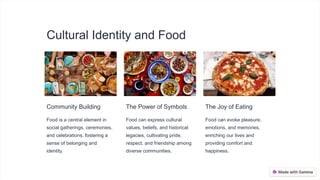Nutrition-and-Culture.pptx
- 1. Nutrition and Culture Nutrition and culture are intrinsically linked. Traditional dietary patterns and modern food systems shape our identities and influence our health. Let's explore this fascinating topic together. HR by Hamdi Rage
- 2. Traditional Diets Mediterranean A diet rich in olive oil, fish, nuts, fruits, and vegetables. Studies show it can help reduce the risk of heart disease, cancer, and Alzheimer's. Japanese Based on rice, vegetables, seafood, and small portions of meat. Its balance of macronutrients and low saturated fat have been linked to longevity and a lower risk of chronic diseases. African A diet of milk, meat, and blood from cattle, with some plant- based foods. It's high in protein, iron, and calcium but also in cholesterol and saturated fat. Mexican Based on corn, beans, chili peppers, tomatoes, and avocado. It's a source of fiber,
- 3. Globalization and Standardization The Fast Food Effect Western fast food chains have spread worldwide, offering convenient and cheap meals that are often high in calories, salt, and fat. The Supermarket Trap Supermarkets often favor processed foods and industrial agriculture, pushing local farmers and traditional food systems out of the market. The Health Consequences The shift towards a high- energy, low-nutrient diet has contributed to a rise in obesity, type-2 diabetes, and other diet-related chronic diseases worldwide.
- 4. Adapting Traditional Diets 1 Modern Twists Some traditional dishes can be adapted to modern lifestyles by reducing animal fats, salt, and sugar, and increasing whole grains, nuts, and legumes. 2 Sustainable Alternatives Local food movements and eco-gastronomy can promote biodiversity, support local producers, and preserve cultural heritage while offering healthy and tasty options. 3 Nutrition Education Teaching people how to choose, prepare, and enjoy traditional foods can increase their awareness of the importance of a varied and balanced diet while valuing cultural diversity.
- 5. Cultural Identity and Food Community Building Food is a central element in social gatherings, ceremonies, and celebrations, fostering a sense of belonging and identity. The Power of Symbols Food can express cultural values, beliefs, and historical legacies, cultivating pride, respect, and friendship among diverse communities. The Joy of Eating Food can evoke pleasure, emotions, and memories, enriching our lives and providing comfort and happiness.
- 6. Cultural Competence 1 Awareness Recognizing and respecting cultural diversity in food habits and traditions. 2 Knowledge Learning about the cultural, historical, and nutritional aspects of traditional diets. 3 Skills Developing the ability to communicate, interact, and collaborate with diverse populations around food issues.
- 7. Conclusion and Call to Action 1 Nutrition is culture-specific Healthier diets need to be adapted to cultural contexts. 2 Cultural diversity is an asset Food is a bridge, not a barrier, among cultures. 3 Education is key Nutrition education should include cultural competence training. 4 Action starts with you Join the movement for healthy and sustainable food systems that recognize the richness of cultural diversity in the world.






